There’s just something about a green grass yard. Whether the verdant base is a backdrop for other, more elaborate plantings or a well-used spot for outdoor games and festivities, your yard is likely a key part of your home’s look and feel. If you want to get new grass growing in a bare spot or boost a worn-down section of your yard, the process involves a bit more than just sprinkling some grass seeds onto the ground. A great deal of it comes down to timing. Spring may seem like the best time to sow grass seed, but it can present some challenges depending on where you live and what kind of grass you want to grow. Many experts actually note that late summer and early autumn are better times.
When it comes to sowing grass seed in the spring, though, it’s not impossible. But there are a number of things to keep in mind to ensure your efforts are successful at this time of year, from prepping your soil adequately, keeping an eye on the weather, and watering correctly to staying on top of weed control. Read on for the best tips and tricks to get new grass sprouting and growing well from seed in the springtime.
Prepping your soil is the best way to set new grass seed up for success
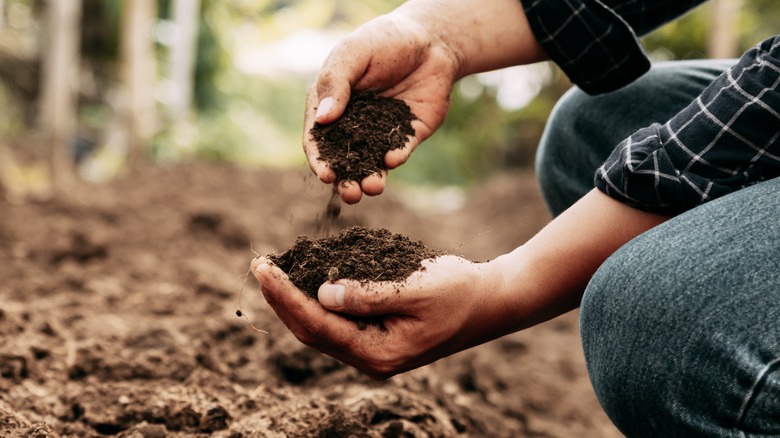
The work of sowing grass seeds in the springtime begins well before the seeds ever make contact with the soil. The soil itself needs to be considered and amended if needed. A soil test will let you know if any additives would be helpful. The majority of turfgrasses, for example, grow best in neutral soils, not those that are heavily acidic or alkaline-based. You may want to consider adding fertilizer to start the seeds off strongly. Weed removal will also need to be undertaken to keep weeds from crowding out the new grass seedlings.
Preparations done at this stage will ensure that the grass seeds go into the germination process with a strong foundation. This work will keep the seeds from struggling to grow in inhospitable soils or competing for dominance against pesky, intrusive weeds. In the fight against weeds, it’s best to pull them up by hand at this time. Weed-prevention products could damage or kill the new grass seeds.
Your grass seeds should be well suited for your climate
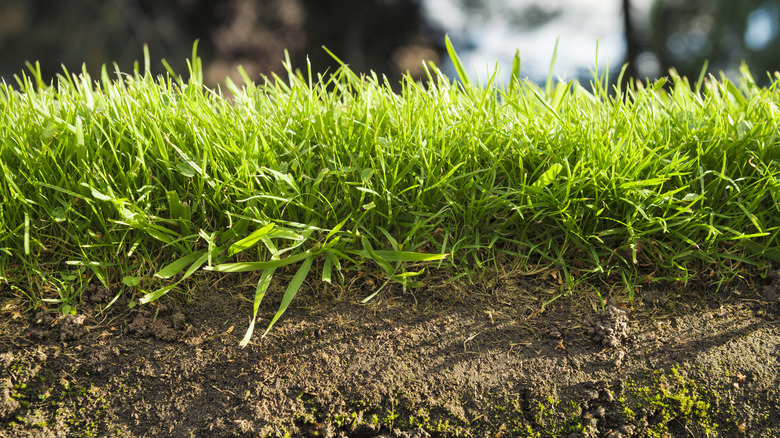
As important as prep work is when you’re setting out to seed new grass in your yard space, so is the type of seeds you’ll be planting. When selecting your grass seeds, ask yourself this: Are they a warm-season grass or a cool-season grass? Warm-season grasses include varieties like Bahia, St. Augustine, zoysia, and Bermuda, while tall and fine fescue, Kentucky bluegrass, and perennial ryegrass are among the cool-season grasses. Soil temperatures, as well as year-round temperature ranges and day lengths in your area, will affect the success of the type of seeds you choose.
Growing a cool-season grass successfully in a very hot climate (and vice versa) will likely prove to be a tall order. Where you live will also impact your best seeding times. Cool-season grasses are more easily started from seed at different times during the year, but many warm-season varieties grow from seed best only later in the spring. In terms of germination, many cool-season grasses will sprout quickly, while warmer-season grasses can take a few weeks longer.
Make sure your grass seeds get into the soil
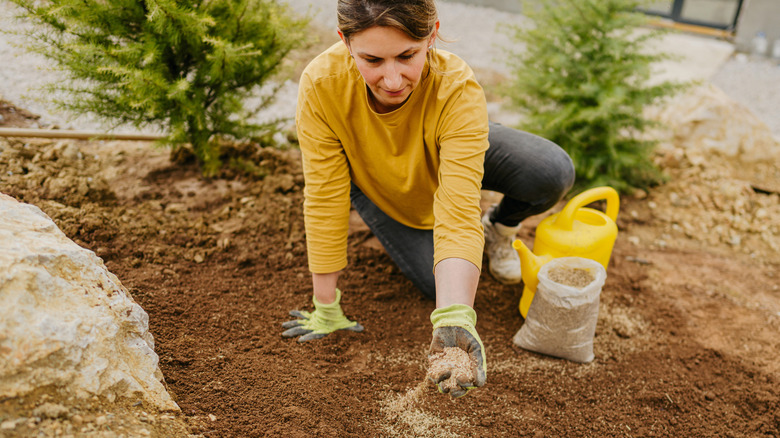
Aleksandarnakic/Getty Images
Initially, it may seem like planting new grass seeds is just a matter of sprinkling your chosen variety around where you’d like to have some fresh new grass. But beyond amending your soil and prepping it as needed, those little seeds will need to be set into the ground. When grass-seeding, it’s important to be sure the seeds you’re sowing are not only making contact with the soil but also staying in place there. Just spreading the seeds onto bare spots is not enough to ensure a successful new patch of grass.
Merely dropping the seeds around will invariably produce a less-than-stellar patch of grass. To spread the seeds correctly, or “broadcast” them, in horticultural terms, as highlighted by Kansas State University’s Research and Extension department, care should be taken to both set the seeds into the ground and keep them there. Consider a method like verticutting, a technique that introduces the seeds into the soil through cut grooves. It’s one proven method to boost germination rates and set the seeds up for success. According to No Ka Oi Landscape Services, based on the Hawaiian island of Kauai, verticutting “removes thatch buildup in the lawn so turf can breathe easy, better absorb nutrients, and soak in much-needed moisture.” This can be done with a rake or, for larger spaces, by landscape professionals with bigger equipment.
Watering wisely will get your new grass seeds off to a great start
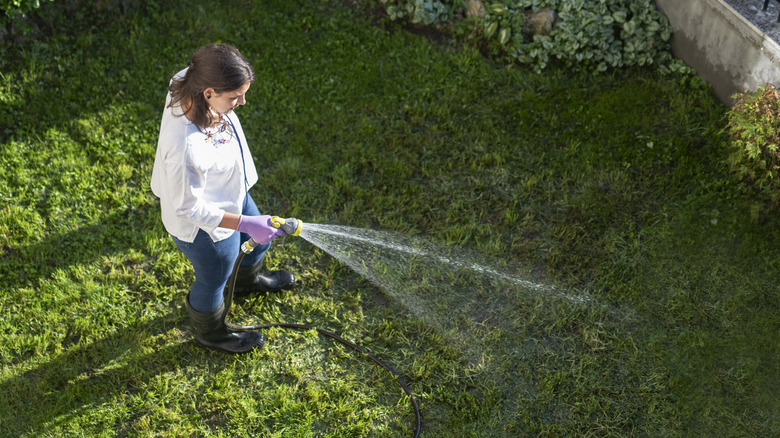
Artistgndphotography/Getty Images
When it comes to watering newly sowed grass seeds, aim to water wisely. How much, and when, to water will depend largely on where you live and how much natural rainfall the seeded area will be receiving. Watering may need to be done daily if you live in a dry climate or are experiencing a dry period or drought conditions. The new seeds will need to get adequate amounts of moisture in order to establish.
Finding that “just right” balance is key with watering. If drought conditions are expected where you live or you’re not able to frequently water the new grass seeds as much as needed, you’ll run the risk of the seeded area drying out, which will result in the new grass dying off. Too much moisture, on the other hand, could introduce fungal diseases to the new plantings. Also, planting grass seed ahead of a rainstorm could result in the seeds washing away to other areas where you’re not intending to grow grass.
Fertilizing new grass seedlings can encourage early development

Ziga Plahutar/Getty Images
After you’ve prepped, placed, and properly irrigated your seeds, assuming of course that soil temps are warm enough where you live, it’s time to consider another boost for growing new grass in the springtime. Applying a fertilizer to new grass seedlings can help to encourage their growth and development. The three major nutrients the seedlings will need are potassium, nitrogen, and phosphorus, which can be found in both synthetic and natural fertilizers.
Not adding a fertilizer of some kind could stunt the growth of the new grass. According to Aaron Patton, an assistant professor and turfgrass extension specialist at Purdue University in Indiana, “New turfgrass seedlings have poorly developed root systems and thus they cannot [effectively] take up the nutrients from the soil.” While the benefits of both synthetic and natural fertilizers will include a boost to new grass seedlings, there can be drawbacks to keep in mind with whichever you choose. Many people opt against chemical-based, synthetic fertilizers because of concerns about their effects on people, pets, and wildlife. Natural and organic fertilizers eliminate that concern, but results can take longer to be seen than with synthetic fertilizers. Also, because many natural fertilizers are bulkier, you may need greater quantities of this type of fertilizer to get the job done.
New grass needs time to grow and establish before mowing
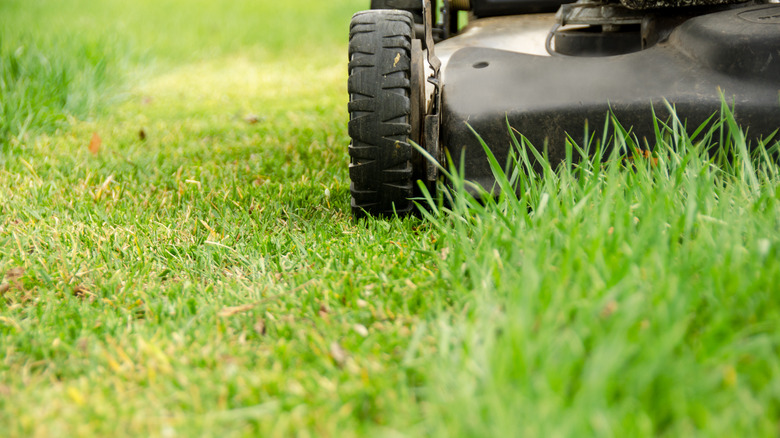
Wwing/Getty Images
When new green grass is growing, growing, growing, it may be tempting to think it’s time for one of the most universal of all yard tasks: mowing. However, it’s critical with new grass growth to know when to mow. New grass seedling sprouts need time for their roots to establish in the ground. This generally takes around a month or two. The best rule of thumb when mowing both new and established grass is to try not to mow down more than a third of the length in one cutting.
Mowing new grass growth too early can damage or even pull up the still-settling-in seedlings. And mowing the blades of grass further down than a third of their lengths can weaken them. As springtime marches on, keeping in mind these two important bits of advice will give your new grass time to strengthen in the ground and grow more robustly as the summertime quickly approaches.
Keep on top of weeding to give new grass seedlings room to grow
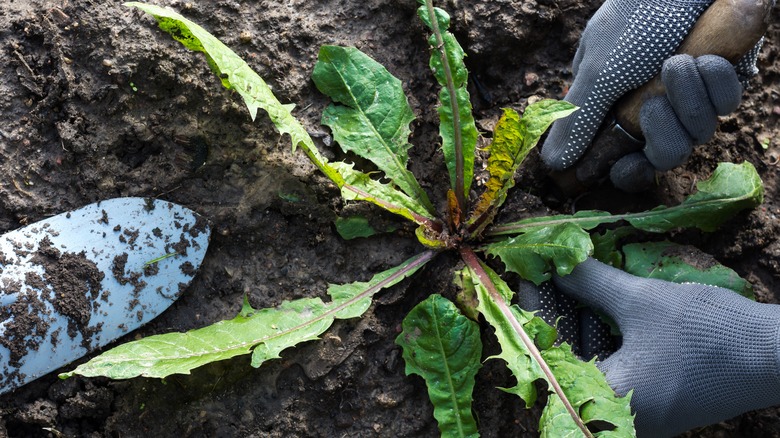
Jurga Jot/Shutterstock
Weeds, such as persistently troublesome varieties like crabgrass, can challenge new grass seeds that are also trying to grow in the same space. Keeping on top of weed control regularly through easy, DIY methods like digging will ensure the new grass seed has room to grow and establish. Garden tools like hoes and sickle blades will make quick work of pulling up many weeds. Also, organic herbicide options like corn gluten and horticultural white vinegar are effective natural combatants when applied to weeds.
Without consistent and frequent weed control, new grass seedlings will struggle to find room to establish and grow. Crabgrass in particular thrives in dry conditions. If you’re using organic herbicides, these can either stunt or kill whatever else is growing by the weeds, so care should be taken when applying them. An additionally important caveat is to initially hold off on weed control treatments for the delicate new grass. After you’ve been able to mow the area around three to five times, then treatments can be applied.



